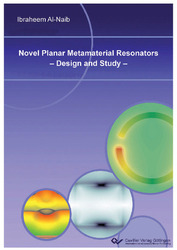| Areas | |
|---|---|
| Serie de libros (96) |
1378
|
| Nachhaltigkeit |
3
|
| Gesundheitswesen |
1
|
| Letra |
2362
|
| Ciencias Naturales |
5406
|
| Ciencias Ingeniería |
1790
|
| Ingeniería | 291 |
| Ingeniería mecánica y de proceso | 861 |
| Ingeniería eléctrica | 686 |
| Mineria y metalurgía | 30 |
| Arquitectura e ingeniería civil | 75 |
| General |
97
|
|
Leitlinien Unfallchirurgie
5. Auflage bestellen |
|
Erweiterte Suche
Novel Planar Metamaterial Resonators -Design and Study- (Tienda española)
Ibraheem Al-Naib (Autor)Previo
Indice, Datei (28 KB)
Lectura de prueba, Datei (170 KB)
One of the most important developing fields is that of digital communication. This is due to the demand for an increasingly higher speed in the exchange of information, which is presently growing at an exponential rate. In fact, considerable efforts have been made towards the realization of low-power miniaturized radio frequency components. However, issues related to design and fabrication of efficient, ultra-compact, and easily integrate-able microwave components appear to be challenging. Many unit cells are needed in order to achieve high efficiency components, such as filters and couplers, whose dimensions are comparable or larger than a single wavelength cycle. However, during the past decade, metamaterials, a novel class of artificial materials, have become a field of active research in physics and engineering. These metamaterials offer unique electrodynamic properties, which are neither available in any natural material nor observable in the materials presently used in state-of-the-art technology. Furthermore, a metamaterials unit cell is much smaller than the wavelength of reference.
The main objective of my dissertation was to design and realize new resonator structures to meet the challenges of simple, high performance, and miniaturized microwave circuits as well as terahertz components for filtering and sensing applications. First of all, I suggested a series of novel structures for filter applications. They consist of only a single metal layer, an approach which I suggested for the first time worldwide. Later on, I realized more advanced miniaturized resonators based on the same idea.
Secondly, although microwave filters are often physically very compact, they can contribute significantly to the delay in microwave circuits. The study of the group delay is very important in radar and ultra-wideband communication systems. Moreover, group delay issues are crucial in wireless communication systems. The bit rate of such systems is highly affected by the group delay of the system’s components. Therefore, studying the group delay behavior for microwave filters is quite important from a system perspective. My work presents a study on the group delay behavior of coplanar waveguide structures loaded with pairs of split-ring resonators and strip lines.
Finally, frequency selective surface (FSS) devices (also known as planar metamaterials) are highly desirable for efficient sensor and filter designs. Conventional FSSs are simply unable to provide the large-volume confinement of the electromagnetic field necessary to support high quality (-Q) resonances. A new kind of asymmetrical resonators is exploited for thin-film sensing. It offers a very high sensitivity at very small scales. Instead of a conventional FSS free-space setup, a single mode rectangular waveguide has been employed with a single asymmetrical double split resonator (aDSR) positioned inside. The above sensor concept can be easily miniaturized through the linear scaling of its geometrical dimensions for sensing applications at higher frequencies, e.g. in the terahertz regime. While aDSRs provide a stopband behavior, many applications require just the dual response, i.e. a passband characteristic. I appeal to this need by applying Babinet’s principle to aDSRs. The resulting structures are complementary aDSRs, which offer the desired dual behavior. The Q-factor of the above structures is much higher than that of conventional resonators, however the size needs to be further reduced. This motivates me to propose a new structure with single split geometry. Not only it has much better performances, but its size is less than half that of aDSRs.
| ISBN-10 (Impresion) | 3869552344 |
| ISBN-13 (Impresion) | 9783869552347 |
| ISBN-13 (E-Book) | 9783736932340 |
| Formato | A5 |
| Idioma | Inglés |
| Numero de paginas | 116 |
| Laminacion de la cubierta | mate |
| Edicion | 1 Aufl. |
| Volumen | 0 |
| Lugar de publicacion | Göttingen |
| Lugar de la disertacion | TU Braunschweig |
| Fecha de publicacion | 14.01.2010 |
| Clasificacion simple | Tesis doctoral |
| Area |
Ingeniería eléctrica
|
| Palabras claves | Hochfrequenztechnik |








